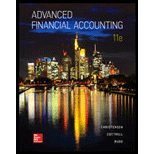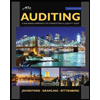
Advanced Financial Accounting
11th Edition
ISBN: 9780078025877
Author: Theodore E. Christensen, David M Cottrell, Cassy JH Budd Advanced Financial Accounting
Publisher: McGraw-Hill Education
expand_more
expand_more
format_list_bulleted
Question
Chapter 14, Problem 14.6.5E
To determine
Introduction: Securities Act of 1933 which is passed in 1933 for security exchange works with the motive to secure the investors so that they can get financial and other important information related to securities issued in public sale and also to have a check on activities like fraud, misrepresentation, etc.Regulation A tier I regulation provides exemption from registration for public offering and issues and has two offerings i.e. Tier I and Tier II. Tier I offering allows up to $ 20million within a year while tier II allows up to $ 50million within a year.
To choose: The correct answer.
Expert Solution & Answer
Want to see the full answer?
Check out a sample textbook solution
Students have asked these similar questions
Can you solve this general accounting problem with appropriate steps and explanations?
No WRONG ANSWER
I need help with this general accounting question using standard accounting techniques.
Chapter 14 Solutions
Advanced Financial Accounting
Ch. 14 - Prob. 14.1QCh. 14 - Prob. 14.2QCh. 14 - Prob. 14.3QCh. 14 - Prob. 14.4QCh. 14 - Prob. 14.5QCh. 14 - Prob. 14.6QCh. 14 - Prob. 14.7QCh. 14 - Prob. 14.8QCh. 14 - Prob. 14.9QCh. 14 - Prob. 14.10Q
Ch. 14 - What type of items that specially involve the...Ch. 14 - Prob. 14.12QCh. 14 - Prob. 14.13QCh. 14 - What types of information must be disclosed in the...Ch. 14 - Prob. 14.15QCh. 14 - Objectives of Securities Acts [CMA Adapted] During...Ch. 14 - Prob. 14.7CCh. 14 - Prob. 14.8CCh. 14 - Prob. 14.1.1ECh. 14 - Prob. 14.1.2ECh. 14 - Organization Structure and Regulatory Authority of...Ch. 14 - Prob. 14.1.4ECh. 14 - Prob. 14.1.5ECh. 14 - Prob. 14.1.6ECh. 14 - Prob. 14.2.1ECh. 14 - Prob. 14.2.2ECh. 14 - Prob. 14.2.3ECh. 14 - Prob. 14.3.1ECh. 14 - Prob. 14.3.2ECh. 14 - Prob. 14.3.3ECh. 14 - Prob. 14.3.4ECh. 14 - Prob. 14.3.5ECh. 14 - Prob. 14.3.6ECh. 14 - Prob. 14.3.7ECh. 14 - Prob. 14.4.1ECh. 14 - Prob. 14.4.2ECh. 14 - Prob. 14.4.3ECh. 14 - Prob. 14.4.4ECh. 14 - Prob. 14.6.1ECh. 14 - Prob. 14.6.2ECh. 14 - Prob. 14.6.3ECh. 14 - Prob. 14.6.4ECh. 14 - Prob. 14.6.5ECh. 14 - Prob. 14.6.6ECh. 14 - Prob. 14.6.7E
Knowledge Booster
Similar questions
- Innovations Inc. had a $38,000 beginning inventory and a $45,000 ending inventory. Net sales were $215,000; purchases were $110,000; purchase returns and allowances were $5,000; and freight-in was $9,000. Cost of goods sold for the period is $107,000. What is Innovations Inc.'s gross profit percentage?arrow_forwardCompute Lancaster taxable income for the year.arrow_forwardCan you help me solve this general accounting problem with the correct methodology?arrow_forward
- I am looking for the most effective method for solving this financial accounting problem.arrow_forwardCould you help me solve this financial accounting question using appropriate calculation technical.arrow_forwardPlease provide the correct answer to this general accounting problem using accurate calculations.arrow_forward
- Please provide the solution to this general accounting question using proper accounting principles.arrow_forwardMeagan Industries completes Job #843, which has a standard of 450 labor hours at a standard rate of $24.50 per hour. The job was completed in 420 hours, and the average actual labor rate was $25.20 per hour. What is the labor efficiency (quantity) variance?arrow_forwardSolve this Accounting Problemarrow_forward
- Harmony Beverages produces a fruit juice blend using three ingredients: Apple, Orange, and Mango. The standard mix ratio is 50% Apple, 30% Orange, and 20% Mango. The standard cost per gallon is $2.00 for Apple, $3.50 for Orange, and $5.00 for Mango. Standard production calls for 100 gallons of ingredients to yield 95 gallons of finished juice due to waste. Last week, the company used 60 gallons of Apple, 25 gallons of Orange, and 20 gallons of Mango, which yielded 98 gallons of finished juice. Calculate the materials yield variance.arrow_forwardWhat is the company's projected net operating profit after tax for 2024?arrow_forwardCan you solve this general accounting problem using appropriate accounting principles?arrow_forward
arrow_back_ios
SEE MORE QUESTIONS
arrow_forward_ios
Recommended textbooks for you
 Auditing: A Risk Based-Approach to Conducting a Q...AccountingISBN:9781305080577Author:Karla M Johnstone, Audrey A. Gramling, Larry E. RittenbergPublisher:South-Western College Pub
Auditing: A Risk Based-Approach to Conducting a Q...AccountingISBN:9781305080577Author:Karla M Johnstone, Audrey A. Gramling, Larry E. RittenbergPublisher:South-Western College Pub Auditing: A Risk Based-Approach (MindTap Course L...AccountingISBN:9781337619455Author:Karla M Johnstone, Audrey A. Gramling, Larry E. RittenbergPublisher:Cengage Learning
Auditing: A Risk Based-Approach (MindTap Course L...AccountingISBN:9781337619455Author:Karla M Johnstone, Audrey A. Gramling, Larry E. RittenbergPublisher:Cengage Learning- Principles of Accounting Volume 1AccountingISBN:9781947172685Author:OpenStaxPublisher:OpenStax College

Auditing: A Risk Based-Approach to Conducting a Q...
Accounting
ISBN:9781305080577
Author:Karla M Johnstone, Audrey A. Gramling, Larry E. Rittenberg
Publisher:South-Western College Pub


Auditing: A Risk Based-Approach (MindTap Course L...
Accounting
ISBN:9781337619455
Author:Karla M Johnstone, Audrey A. Gramling, Larry E. Rittenberg
Publisher:Cengage Learning

Principles of Accounting Volume 1
Accounting
ISBN:9781947172685
Author:OpenStax
Publisher:OpenStax College